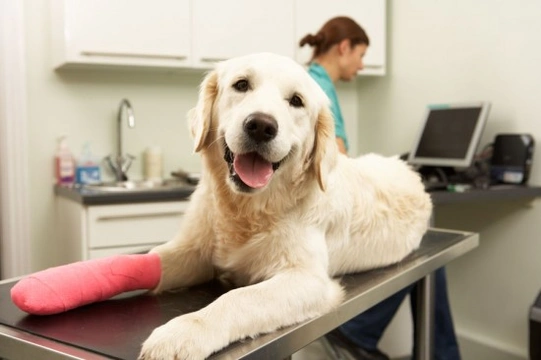
Joint Injuries in Dogs
It's the moment every dog owner dreads: you're out playing or exercising with your pet and he comes home with a strange limp. The problem doesn't go away after a few hours, and you begin to worry. Any active dog can suffer from joint issues, which can be the result of injury or genetics. These problems can be expensive to diagnose and may require surgery or specialist care to treat. Learn more about the most common joint problems in dogs, as well as how to handle them by reading this article.
Why are dogs so prone to joint damage?
Dogs take a lot of wear and tear over the course of their lives. Running on hard surfaces, jumping and rough play can all lead to degenerative problems and injuries like ligament tearing or dislocations. Joint problems can occur at any age in any breed, and run the gamut from osteoarthritis to the dreaded torn cruciate ligament. Hereditary factors also come into play, especially in certain purebred dogs. There are some breeds which are more prone to hip and elbow dysplasia, in which the joints of these respective areas do not develop normally. A luxating patella, or dislocated kneecap, can also occur as a result of congenital problems. There are many other problems, but these are amongst the most common.Finally, the overall health of your pet can contribute to his joint health. Overweight or obese animals have more strain on their joints, thereby making them more vulnerable to joint disorders and injury. Fat can also act as an inflammatory agent in the joint and cause discomfort.
What symptoms should I look for to determine if my dog has joint problems?
Besides limping, you may also notice subtler changes if your pet has joint pain as a result of a degenerative condition. Signs include:
- Difficulty climbing or descending stairs
- Limb or hip stiffness
- Swelling or fluid build-up around the joints
- Abducted limb posture
- Lethargy
- Unusual gait
What can I do if I notice my dog is limping after activity?
Try to remain calm and take note of how and when the injury happened. Your vet will need to know this information to help with his or her diagnosis. Sometimes limping due to a non-hereditary injury can resolve on its own if the affected limb is rested for a few days. Depending on how severe your dog's symptoms are, kennel rest and limited walks may relieve minor problems. You should always call your vet as soon as you notice something is amiss, but be prepared to keep your pet dog in an enclosed space with no free-range exercise.In the case of severe limping or bleeding, going to the vet is even more important as you'll want to ensure that your pet hasn't accidentally stepped on a sharp object or picked up a foreign body. Treatment for more serious limps may include emergency x-rays, non-steroidal pain relief to reduce inflammation, and antibiotics in the case of an open wound.
What treatment options are available for joint injuries?
Pets with serious joint injuries may be hospitalised, so that their pain levels can be monitored and surgery can commence as early as possible. Operations for other, less urgent disorders may be done by specialists. Depending on the injury, your options may include joint cleaning or even complete replacement of the affected joint. If your pet is overweight, your vet may recommend an exercise regime or special diet to help him shed pounds.
How much does joint treatment cost?
Diagnosis, surgery and medical care relating to joint injuries can be extremely expensive and may require long periods of follow-up therapy. In some cases, referral to orthopaedic specialists may be necessary, and if your pet re quires emergency out-of-hours care then costs can quickly add up. Complementary therapy is also considered very important in the long-term treatment of joint pain. All of this can easily add up to thousands of pounds! In order to manage costs, it is important that you have planned for the worst in advance, well before your dog is injured or develops pain. Research pet insurance policies and find one that covers both primary and complementary treatments, or that offers life-long coverage. Alternatively, you can set aside an ISA each year with savings for your pet's veterinary care - the only downside being that it can take several years worth of savings to fully cover emergency or specialist care.
How can I help my dog recover from bone or joint surgery?
Speak to your vet about any special instructions required following an operation. It is absolutely essential that you follow your vet's advice to ensure your pet makes a full recovery - failing to do so may cause the problem to reoccur or worsen. You may have to keep your pet confined or limit the length of walks you take him on for a number of weeks. To prevent boredom, keep your dog's kennel stocked with safe toys and food puzzles. If your dog is not prone to over-excitement, you should try to keep the kennel in an interesting spot where your dog can still interact with family members. You will also need to make sure your pet gets his medicine, as some of the drugs will help prevent infection or keep inflammation down. If you believe your pet is still in pain after taking his prescriptions, always consult your vet before giving any further medication. Double dosing of drugs can cause serious organ damage, so make sure you understand how and when drugs should be administered.Work with your vet to develop a therapy regime to promote normal movement and help your pet regain strength in the affected joint. This may include physio or hydrotherapy. Many joint injuries are associated with the development of arthritis later in life, so make sure to discuss preventative options with your vet. Certain supplements like fish oils may help keep inflammation down and preserve joint health.



